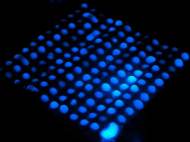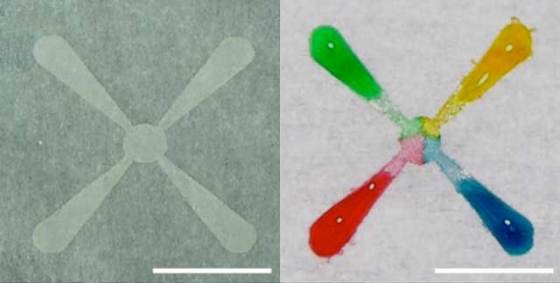Cheap and disposable paper strips could be used for chemical analysis
 Current lab-on-a-chip technology is relatively expensive because chips must be specifically designed to perform certain types of chemical analyses, with channels created in glass or plastic and tiny pumps and valves directing the flow of fluids for testing. In order to counter that, the researchers from Perdue University have invented a technique that uses inexpensive paper to produce micro-fluidic devices for rapid medical diagnostics and chemical analysis.
Current lab-on-a-chip technology is relatively expensive because chips must be specifically designed to perform certain types of chemical analyses, with channels created in glass or plastic and tiny pumps and valves directing the flow of fluids for testing. In order to counter that, the researchers from Perdue University have invented a technique that uses inexpensive paper to produce micro-fluidic devices for rapid medical diagnostics and chemical analysis.
“With current systems that use paper test strips you can measure things like pH or blood sugar, but you can’t perform more complex chemical assays”, said Babak Ziaie, a Purdue University professor of electrical and computer engineering and biomedical engineering, whose research is based at the Birck Nanotechnology Center in the university’s Discovery Park. “This new approach offers the potential to extend the inexpensive paper-based systems so that they are able to do more complicated multiple analyses on the same piece of paper. It’s a generic platform that can be used for a variety of applications.”
The new technique is simpler because the testing platform will be contained on a disposable paper strip containing patterns created by a laser. The researchers start with paper having a hydrophobic (water-repellant) coating, such as parchment paper or wax paper used for cooking. A laser is used to burn off the hydrophobic coatings in lines, dots and patterns, exposing the underlying water-absorbing paper only where the patterns are formed.
“Since the hydrophobic agent is already present throughout the thickness of the paper, our method creates islands of hydrophilic patterns”, said Ziaie. “This modified surface has a highly porous structure, which helps to trap and localize chemical and biological aqueous reagents for analysis. Furthermore, we’ve selectively deposited silica microparticles on patterned areas to allow diffusion from one end of a channel to the other.”
Those microparticles aid to draw the liquid to a location where it would combine with another chemical, called a reactant, causing it to change colors and indicating a positive or negative test result. To demonstrate the new concept, the researchers created paper strips containing arrays of dots dipped in luminol, a chemical that turns fluorescent blue when exposed to blood. There are other methods that lay down lines of wax or other hydrophobic material on top of untreated hydrophilic paper, but the researchers claim their method is superior.
“Our process is much easier because we just use a laser to create patterns on paper you can purchase commercially and it is already impregnated with hydrophobic material”, said Ziaie. “It’s a one-step process that could be used to manufacture an inexpensive diagnostic tool for the developing world where people can’t afford more expensive analytical technologies.”
The strips could be treated with chemicals that cause color changes when exposed to a liquid sample, including different portions of the pattern which would reveal specific details about the content of the sample. The innovation could lower the price of the commercially available diagnostic devices that use paper-strip assays like those that test for diabetes and pregnancy.
For more information, read their paper published in the online journal Lab on Chip named: “Laser-treated hydrophobic paper: an inexpensive microfluidic platform”.










Leave your response!